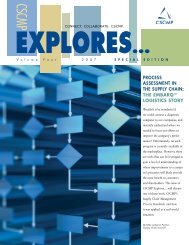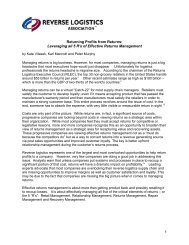is your metrics program measuring up? - Supply Chain Visions
is your metrics program measuring up? - Supply Chain Visions
is your metrics program measuring up? - Supply Chain Visions
You also want an ePaper? Increase the reach of your titles
YUMPU automatically turns print PDFs into web optimized ePapers that Google loves.
If you’re interested in submitting an idea<br />
or proposal for CLM Explores…, please<br />
contact the Research Coordinator at<br />
CLMResearch@CLM1.org.<br />
CLM CLM<br />
EXPLORES...<br />
Explores… <strong>is</strong> publ<strong>is</strong>hed five times a year<br />
by the Council of Log<strong>is</strong>tics Management<br />
2805 Butterfield Road, Suite 200<br />
Oak Brook, IL 60523-1170 USA<br />
Phone: (630) 574-0985 Fax (630) 574-0989<br />
Web site: www.clm1.org<br />
Editor: Madeleine Miller-Holodnicki<br />
Direct line: (630) 645-3487<br />
E-mail: mholodnicki@clm1.org<br />
2<br />
© Copyright 2004 Council of Log<strong>is</strong>tics Management<br />
Is Your Metrics Program Measuring Up?<br />
The Building Blocks of a Successful<br />
Performance Management Program . . . . . . . . . . . . . . . . . . . . . 3<br />
The Foundation: Aligning Metrics to Strategy . . . . . . . . . . . . . 3–4<br />
Metrics systems make v<strong>is</strong>ion statements real<br />
Have you fallen into a measurement trap?<br />
The Vital Few: The importance of a handful of<br />
<strong>metrics</strong> that are the strategic focus of activities<br />
Building Block 1: Process, Not Functional Metrics . . . . . . . . . . 4–5<br />
Building Block 2: Use Balanced Metrics . . . . . . . . . . . . . . . . . . . . 5<br />
Building Block 3: Embed Metrics in Your Culture . . . . . . . . . . . 5–6<br />
Building Block 4: Link Metrics to an<br />
Incentive/Compensation Plan . . . . . . . . . . . . . . . . . . . . . . . . 6–7<br />
Building Block 5: Use Tools and Technology to<br />
Make Metrics Tracking Easier . . . . . . . . . . . . . . . . . . . . . . . . . . 7<br />
Summary. . . . . . . . . . . . . . . . . . . . . . . . . . . . . . . . . . . . . . . . . . . 7<br />
How Does Your Metrics Program Measure Up? . . . . . . . . . . . . 7–8<br />
BIBLIOGRAPHY<br />
1 Lew<strong>is</strong> Carroll, Alice’s Adventures in Wonderland, Macmillan and Co., London, England, 1865<br />
2 Steven Hronec and Arthur Anderson & Co., Vital Signs, Amacon, 1993, p 14<br />
3 “S<strong>up</strong>ply <strong>Chain</strong> Management Blues,” Modern Materials Handling, August 1, 2003<br />
4 Andy Neeley and Chr<strong>is</strong> Adams, “Perspectives on Performance: The Performance Pr<strong>is</strong>m,” Focus Magazine (online<br />
publication), August 2000, p 4<br />
5 George A. Miller, “The Magical Number Seven, Plus or Minus Two: Some Limits on our Capacity for Processing<br />
Information,” The Psychological Review, Vol 63, 1956, pp. 81-97<br />
6 Gregory P. Reilly and Raymond R. Reilly “Improving Corporate Performance Measurement” Journal of Cost<br />
Management, July/August 2001, pp. 42-44<br />
7 Robert S. Kaplan and David P. Norton, “The Balanced Scorecard–Measures that Drive Performance,” Harvard<br />
Business Review, Jan/Feb 1992<br />
8 For additional information, please see:<br />
Robert S. Kaplan and David P. Norton, “Using the Balanced Scorecard as a Strategic Management System,”<br />
Harvard Business Review, Vol 74, No 1, 1996, pp. 78-98<br />
Robert S. Kaplan and David P. Norton, The Balanced Scorecard: Translating Strategy into Action, Harvard<br />
Business School Press, Boston, 1996<br />
Robert S. Kaplan and David P. Norton, The Strategy-Focused Organization, Harvard Business School Press,<br />
Boston, 2001<br />
9 William A. Schiemann and John H. Lingle, “Seven Greatest Myths Of Measurement,” Management Review, 86(5)<br />
(1997), pp. 29-32.<br />
10 For additional information, see http://www.<strong>is</strong>ixsigma.com or similar reference sites.<br />
11 For additional information, see http://www.asq.org/basics/pdca.html or similar reference sites,<br />
12 Stephen Barr, “Postal Service Tries Pay-for-Performance System for Management,” Washington Post, January 15,<br />
2004, p B02<br />
13 The Hawthorne effect refers to an increase in worker productivity produced by the psychological stimulus of being<br />
singled out and made to feel important. The concept was demonstrated in a research project (1927-1932) of the<br />
Hawthorne Plant of the Western Electric Company in Cicero, Illino<strong>is</strong> which was led by Harvard Business School professor<br />
Elton Mayo along with associates F.J. Roethl<strong>is</strong>berger and William J. Dickson.<br />
Source—Franke, R.H. & Kaul, JD “The Hawthorne Experiments: First Stat<strong>is</strong>tical Interpretation.” American<br />
Sociological Review, 1978, 43, pp. 623-643




